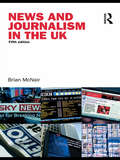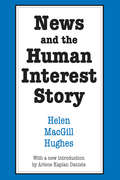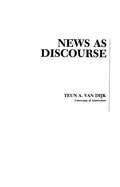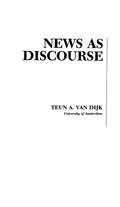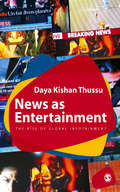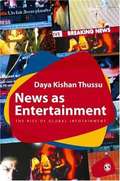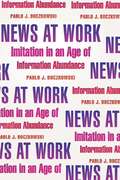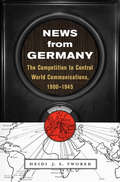- Table View
- List View
News and Civil Society: The Contested Space of Civil Society in UK Media
by Jen BirksCivil Society has not been more relevant as a concept and a practice since the fall of communism in Eastern Europe. Global events from Tahir Square to Wall St have brought a new relevance and urgency to questions about the boundaries of legitimate dissent and public order policing, the meaning of tolerance in the context of conflicting rights claims, and how we can agree on the shared values of the ’good society’. This timely book examines the representation of civil society in news media, exploring the popular understanding of this contested space in relation to conflicting legitimating frames: as the neo-liberal Big Society, activist political participation, or postmodern apolitical tolerance. With close reference to prominent news stories, including the UK state visit of Pope Benedict XVI, anti-austerity protests and industrial action, police infiltration of the environmental movement, and the Occupy camp at St Paul’s Cathedral in London, News and Civil Society scrutinises different facets of contemporary civil society, civility and civic virtue. A cross-disciplinary engagement with questions of national identity and pluralism, civil liberties and dissent, power and accountability, this book will appeal to those with interests in media, journalism, sociology, citizenship and political studies.
News and Civil Society: The Contested Space of Civil Society in UK Media
by Jen BirksCivil Society has not been more relevant as a concept and a practice since the fall of communism in Eastern Europe. Global events from Tahir Square to Wall St have brought a new relevance and urgency to questions about the boundaries of legitimate dissent and public order policing, the meaning of tolerance in the context of conflicting rights claims, and how we can agree on the shared values of the ’good society’. This timely book examines the representation of civil society in news media, exploring the popular understanding of this contested space in relation to conflicting legitimating frames: as the neo-liberal Big Society, activist political participation, or postmodern apolitical tolerance. With close reference to prominent news stories, including the UK state visit of Pope Benedict XVI, anti-austerity protests and industrial action, police infiltration of the environmental movement, and the Occupy camp at St Paul’s Cathedral in London, News and Civil Society scrutinises different facets of contemporary civil society, civility and civic virtue. A cross-disciplinary engagement with questions of national identity and pluralism, civil liberties and dissent, power and accountability, this book will appeal to those with interests in media, journalism, sociology, citizenship and political studies.
News and How to Use It: What to Believe in a Fake News World
by Alan RusbridgerNothing in life works without facts. A society that isn’t sure what’s true can’t function. Without facts there can be no government or law. Science is ignored. Trust evaporates. People everywhere feel ever more alienated from – and mistrustful of – news and those who make it. We no longer seem to know who or what to believe. We are living through a crisis of ‘information chaos’. News: And How to Use It is a glossary for this bewildering age. From AI to Bots, from Climate Crisis to Fake News, from Clickbait to Trolls (and more), here is the definitive user’s guide for how to stay informed, tell truth from fiction and hold those in power accountable in the modern age.
News and Journalism in the UK
by Brian McNairNews and Journalism in the UK is an accessible and comprehensive introduction to the political, economic and regulatory environments of press and broadcast journalism in Britain and Northern Ireland. Surveying the industry in a period of radical economic and technological change, Brian McNair examines the main trends in journalistic media in the last two decades and assesses the challenges and future of the industry in the new millennium. Integrating both academic and journalistic perspectives on journalism, topics addressed in this revised and updated edition include: the rise of online journalism and the impact of blogging on mainstream journalism the emergence of 24 hour news channels in the UK the role and impact of journalism, with reference to issues such as democracy, health scares and the war on terror trends in media ownership and editorial allegiances 'Tabloidisation', Americanisation and the supposed 'dumbing down' of journalistic standards the implications of devolution for regional journalists.
News and Journalism in the UK
by Brian McNairNews and Journalism in the UK is an accessible and comprehensive introduction to the political, economic and regulatory environments of press and broadcast journalism in Britain and Northern Ireland. Surveying the industry in a period of radical economic and technological change, Brian McNair examines the main trends in journalistic media in the last two decades and assesses the challenges and future of the industry in the new millennium. Integrating both academic and journalistic perspectives on journalism, topics addressed in this revised and updated edition include: the rise of online journalism and the impact of blogging on mainstream journalism the emergence of 24 hour news channels in the UK the role and impact of journalism, with reference to issues such as democracy, health scares and the war on terror trends in media ownership and editorial allegiances 'Tabloidisation', Americanisation and the supposed 'dumbing down' of journalistic standards the implications of devolution for regional journalists.
News and News Sources: A Critical Introduction
by Dr Paul ManningNews and News Sources offers a fresh introduction to the sociology of news. It is often suggested that the powerful dominate news agendas. Increasingly however, less powerful groups are employing sophisticated media strategies and new communication technologies to get their message across. The implications of this development are unclear. Do these developments herald a `democratisation' of news arenas, or will they enable the powerful further strengthen their control over the flow of information to the public domain? News and News Sources: reviews new research in the rapidly expanding field of political communication, drawing upon material from Britain, Europe and the USA; provides a clear introduction to the processes of news production and the implications of the rise in global electronic news communication; and assesses the various theoretical frameworks available for analysing these developments including fuctionalism, pluralism, Marxism, political economy, hegemony theory, discourse theory and postmodernism.
News and Numbers: A Writer's Guide to Statistics
by Victor Cohn Lewis CopeNumbers and statistical claims dominate today's news. Politics, budgets, crime analysis, medical issues, and sports reporting all demand numbers. Now in its third edition, News & Numbers focuses on how to evaluate statistical claims in science, health, medicine, and politics. It does so by helping readers answer three key questions about all scientific studies, polls, and other statistical claims: "What can I believe?" "What does it mean?" and "How can I explain it to others?" Updated throughout, this long overdue third edition brings this classic text up-to-date with the 21st century with a complete updating of examples, case studies, and stories. The text emphasises clear thinking and common sense approaches for understanding, analyzing and explaining statistics, and terms throughout the book are explained in easy-to-understand, nontechnical language. Much new material has been added to ensure the text maintains its pertinent approach to the subject, including: A section on computer modelling Additional chapters on risks and 'missing numbers' Updated sections on health plans and insurance, including updates on President Obama's health system overhaul & new material on health care costs and quality
News and Numbers: A Writer's Guide to Statistics
by Victor Cohn Lewis CopeNumbers and statistical claims dominate today's news. Politics, budgets, crime analysis, medical issues, and sports reporting all demand numbers. Now in its third edition, News & Numbers focuses on how to evaluate statistical claims in science, health, medicine, and politics. It does so by helping readers answer three key questions about all scientific studies, polls, and other statistical claims: "What can I believe?" "What does it mean?" and "How can I explain it to others?" Updated throughout, this long overdue third edition brings this classic text up-to-date with the 21st century with a complete updating of examples, case studies, and stories. The text emphasises clear thinking and common sense approaches for understanding, analyzing and explaining statistics, and terms throughout the book are explained in easy-to-understand, nontechnical language. Much new material has been added to ensure the text maintains its pertinent approach to the subject, including: A section on computer modelling Additional chapters on risks and 'missing numbers' Updated sections on health plans and insurance, including updates on President Obama's health system overhaul & new material on health care costs and quality
News and Politics in the Age of Revolution: Jean Luzac's "Gazette de Leyde"
by Jeremy D. PopkinJeremy D. Popkin's book is the first comprehensive examination of the European news industry during the era of the American and French Revolutions. He focuses on the Gazette de Leyde, the period's newspaper of record, and constructs a detailed picture of the'media market'of which it was a part.
News and the Human Interest Story
by Helen MacGill HughesIn this account of the growth of newspapers in modern, industrial society, Helen Hughes traces the development of a mass audience through analysis of the origins of the human interest story in the popular ballads of an earlier day. She shows how such commonly found interests as a taste for news of the town, ordinary gossip, and moving or gripping tales with a legendary or mythic quality have reflected the tastes of ordinary folk from the days of illiterate audiences to the present. She explains how these interests ultimately were combined with practical economic and political information to create the substance and demand for a popular press.In describing the rise and fall of newspaper empires, each with their special readership attractions, Hughes shows how technological innovation and idiosyncratic creativity were used by owners to capture and hold a reading audience. Once this audience developed, it could be fed a variety of messages—beamed at reinforcing and maintaining both general and specific publics—as well as a view of the world consonant with that of the publisher and major advertisers. Hughes offers a persuasive argument for the continuing viability of this method for combined social control, instruction, and amusement captured by the association of news and the human interest story.
News and the Human Interest Story
by Helen MacGill HughesIn this account of the growth of newspapers in modern, industrial society, Helen Hughes traces the development of a mass audience through analysis of the origins of the human interest story in the popular ballads of an earlier day. She shows how such commonly found interests as a taste for news of the town, ordinary gossip, and moving or gripping tales with a legendary or mythic quality have reflected the tastes of ordinary folk from the days of illiterate audiences to the present. She explains how these interests ultimately were combined with practical economic and political information to create the substance and demand for a popular press.In describing the rise and fall of newspaper empires, each with their special readership attractions, Hughes shows how technological innovation and idiosyncratic creativity were used by owners to capture and hold a reading audience. Once this audience developed, it could be fed a variety of messages—beamed at reinforcing and maintaining both general and specific publics—as well as a view of the world consonant with that of the publisher and major advertisers. Hughes offers a persuasive argument for the continuing viability of this method for combined social control, instruction, and amusement captured by the association of news and the human interest story.
News Around the World: Content, Practitioners, and the Public
by Pamela J. Shoemaker Akiba A. CohenWhat's news? A front-page news story in the United States might not appear in a newspaper in China. Or a minor story on German television may be all over the airwaves in India. But News Around the World shows that the underlying nature of news is much the same the world over and that people--no matter what their jobs or their status in society--tend to hold similar notions of newsworthiness. In this richly detailed study of international news, news makers and the audience, the authors have undertaken exhaustive original research within two cities--one major and one peripheral--in each of ten countries: Australia, Chile, China, Germany, India, Israel, Jordan, Russia, South Africa, and the United States. The nations were selected for study based on a central principle of maximizing variation in geographic locations, economic and political systems, languages, sizes, and cultures. The remarkable scope of the research makes this the most comprehensive analysis of newsworthiness around the globe: 10 countries studied, each with a university country director 2 cities in each country examined, one major and one peripheral 60 news media studied (newspapers, television, and radio news programs), resulting in 32,000+ news items analyzed 80 focus groups with journalists, public relations practitioners, and audience members 2,400 newspaper stories ranked according to newsworthiness and compared with how prominently they were published. News Around the World provides remarkable insight into how and why news stories are reported, testing and improving a theory of cross-cultural newsworthiness and is essential reading for anyone seeking to understand international media and journalism.
News Around the World: Content, Practitioners, and the Public
by Pamela J. Shoemaker Akiba A. CohenWhat's news? A front-page news story in the United States might not appear in a newspaper in China. Or a minor story on German television may be all over the airwaves in India. But News Around the World shows that the underlying nature of news is much the same the world over and that people--no matter what their jobs or their status in society--tend to hold similar notions of newsworthiness. In this richly detailed study of international news, news makers and the audience, the authors have undertaken exhaustive original research within two cities--one major and one peripheral--in each of ten countries: Australia, Chile, China, Germany, India, Israel, Jordan, Russia, South Africa, and the United States. The nations were selected for study based on a central principle of maximizing variation in geographic locations, economic and political systems, languages, sizes, and cultures. The remarkable scope of the research makes this the most comprehensive analysis of newsworthiness around the globe: 10 countries studied, each with a university country director 2 cities in each country examined, one major and one peripheral 60 news media studied (newspapers, television, and radio news programs), resulting in 32,000+ news items analyzed 80 focus groups with journalists, public relations practitioners, and audience members 2,400 newspaper stories ranked according to newsworthiness and compared with how prominently they were published. News Around the World provides remarkable insight into how and why news stories are reported, testing and improving a theory of cross-cultural newsworthiness and is essential reading for anyone seeking to understand international media and journalism.
News As Discourse (Routledge Communication Series)
by Teun A. van DijkFirst Published in 1990. Routledge is an imprint of Taylor & Francis, an informa company.
News As Discourse (Routledge Communication Series)
by Teun A. van DijkFirst Published in 1990. Routledge is an imprint of Taylor & Francis, an informa company.
News as Entertainment: The Rise of Global Infotainment
by Daya Thussu"Thussu brings to this project the passion for news of a socially committed former journalist, the political economy of his international relations education and a formidable assembly of global detail, examining the recent explosion of 'infotainment'." - John Downing, Southern Illinois University "Thussu's account of war as infotainment, the Bollywoodization of news and the emergence of a global infotainment sphere is as compelling as it is alarming. This is a significant and essential book for anyone interested in exploring the connections between news journalism, informed citizenship and democracy." - Bob Franklin, The Cardiff School of Journalism, Media and Cultural Studies Richly detailed and empirically grounded, this first book-length study of infotainment and its globalization by a leading scholar of global communication, offers a comprehensive and critical analysis of this emerging phenomenon. Going beyond - both geographically and theoretically - the 'dumbing down' discourse, largely confined to the Anglo-American media, the book argues that infotainment may have an important ideological role, a diversion in which 'soft news' masks the hard realities of neo-liberal imperialism. Chapters include a historical appraisal of infotainment; the infrastructure for its globalization as well as coverage of recent wars on television news as high-tech infotainment and the growing synergies between Hollywood and Bollywood-originated infotainment. A 'global infotainment sphere' is emerging, the book argues, within which competing versions of news - from 24/7 news networks to bloggers - coexist. Accessible, engagingly written and robustly argued, the book combines analyses of theoretical debates on infotainment with extensive and up-to-date comparative data.
News as Entertainment: The Rise of Global Infotainment (PDF)
by Daya Thussu"Thussu brings to this project the passion for news of a socially committed former journalist, the political economy of his international relations education and a formidable assembly of global detail, examining the recent explosion of 'infotainment'." - John Downing, Southern Illinois University "Thussu's account of war as infotainment, the Bollywoodization of news and the emergence of a global infotainment sphere is as compelling as it is alarming. This is a significant and essential book for anyone interested in exploring the connections between news journalism, informed citizenship and democracy." - Bob Franklin, The Cardiff School of Journalism, Media and Cultural Studies Richly detailed and empirically grounded, this first book-length study of infotainment and its globalization by a leading scholar of global communication, offers a comprehensive and critical analysis of this emerging phenomenon. Going beyond - both geographically and theoretically - the 'dumbing down' discourse, largely confined to the Anglo-American media, the book argues that infotainment may have an important ideological role, a diversion in which 'soft news' masks the hard realities of neo-liberal imperialism. Chapters include a historical appraisal of infotainment; the infrastructure for its globalization as well as coverage of recent wars on television news as high-tech infotainment and the growing synergies between Hollywood and Bollywood-originated infotainment. A 'global infotainment sphere' is emerging, the book argues, within which competing versions of news - from 24/7 news networks to bloggers - coexist. Accessible, engagingly written and robustly argued, the book combines analyses of theoretical debates on infotainment with extensive and up-to-date comparative data.
News as Entertainment: The Rise of Global Infotainment (PDF)
by Daya Kishan ThussuThussu brings to this project the passion for news of a socially committed former journalist, the political economy of his international relations education and a formidable assembly of global detail, examining the recent explosion of 'infotainment'. - John Downing, Southern Illinois University Thussu's account of war as infotainment, the Bollywoodization of news and the emergence of a global infotainment sphere is as compelling as it is alarming. This is a significant and essential book for anyone interested in exploring the connections between news journalism, informed citizenship and democracy. - Bob Franklin, The Cardiff School of Journalism, Media and Cultural Studie s Richly detailed and empirically grounded, this first book-length study of infotainment and its globalization by a leading scholar of global communication, offers a comprehensive and critical analysis of this emerging phenomenon. Going beyond - both geographically and theoretically - the 'dumbing down' discourse, largely confined to the Anglo-American media, the book argues that infotainment may have an important ideological role, a diversion in which 'soft news' masks the hard realities of neo-liberal imperialism. Chapters include a historical appraisal of infotainment; the infrastructure for its globalization as well as coverage of recent wars on television news as high-tech infotainment and the growing synergies between Hollywood and Bollywood-originated infotainment. A 'global infotainment sphere' is emerging, the book argues, within which competing versions of news - from 24/7 news networks to bloggers - coexist. Accessible, engagingly written and robustly argued, the book combines analyses of theoretical debates on infotainment with extensive and up-to-date comparative data.
News at Work: Imitation in an Age of Information Abundance
by Pablo J. BoczkowskiBefore news organizations began putting their content online, people got the news in print or on TV and almost always outside of the workplace. But nowadays, most of us keep an eye on the headlines from our desks at work, and we have become accustomed to instant access to a growing supply of constantly updated stories on the Web. This change in the amount of news available as well as how we consume it has been coupled with an unexpected development in editorial labor: rival news organizations can now keep tabs on the competition and imitate them, resulting in a decrease in the diversity of the news. Peeking inside the newsrooms where journalists create stories and the work settings where the public reads them, Pablo J. Boczkowski reveals why journalists contribute to the growing similarity of news—even though they dislike it—and why consumers acquiesce to a media system they find increasingly dissatisfying. Comparing and contrasting two newspapers in Buenos Aires with similar developments in the United States, News at Work offers an enlightening perspective on living in a world with more information but less news.
News at Work: Imitation in an Age of Information Abundance
by Pablo J. BoczkowskiBefore news organizations began putting their content online, people got the news in print or on TV and almost always outside of the workplace. But nowadays, most of us keep an eye on the headlines from our desks at work, and we have become accustomed to instant access to a growing supply of constantly updated stories on the Web. This change in the amount of news available as well as how we consume it has been coupled with an unexpected development in editorial labor: rival news organizations can now keep tabs on the competition and imitate them, resulting in a decrease in the diversity of the news. Peeking inside the newsrooms where journalists create stories and the work settings where the public reads them, Pablo J. Boczkowski reveals why journalists contribute to the growing similarity of news—even though they dislike it—and why consumers acquiesce to a media system they find increasingly dissatisfying. Comparing and contrasting two newspapers in Buenos Aires with similar developments in the United States, News at Work offers an enlightening perspective on living in a world with more information but less news.
News at Work: Imitation in an Age of Information Abundance
by Pablo J. BoczkowskiBefore news organizations began putting their content online, people got the news in print or on TV and almost always outside of the workplace. But nowadays, most of us keep an eye on the headlines from our desks at work, and we have become accustomed to instant access to a growing supply of constantly updated stories on the Web. This change in the amount of news available as well as how we consume it has been coupled with an unexpected development in editorial labor: rival news organizations can now keep tabs on the competition and imitate them, resulting in a decrease in the diversity of the news. Peeking inside the newsrooms where journalists create stories and the work settings where the public reads them, Pablo J. Boczkowski reveals why journalists contribute to the growing similarity of news—even though they dislike it—and why consumers acquiesce to a media system they find increasingly dissatisfying. Comparing and contrasting two newspapers in Buenos Aires with similar developments in the United States, News at Work offers an enlightening perspective on living in a world with more information but less news.
News Discourse and Power: Critical Perspectives on Journalism and Inequality
by Henry Silke, Fergal Quinn and Maria RiederThe issue of socio-economic inequality has become an increasingly important question for journalism and the academy. The 2008 economic crisis and the years of austerity which followed exasperated class and regional division and as an even greater economic shock emerges from the aftermath of the Covid 19 pandemic, the role of journalism and the wider media in the production and reproduction of inequality assumes greater importance. This edited collection includes eight chapters examining instances of where inequality is examined in the media, for example coverage of Thomas Piketty, precarity, corporate tax rates and race-, class- and gender-related issues, in order to address the following questions: Does journalism treat the issue of inequality in a satisfactory fashion? Does journalism challenge powerful interests, or does journalism play an ideological role in the reproduction of structures of inequality itself? How do increasingly poor working conditions of journalists impact on the coverage of inequality? The chapters in this book were originally published as a special issue of the Critical Discourse Studies journal.
News Discourse and Power: Critical Perspectives on Journalism and Inequality
by Henry Silke Fergal Quinn Maria RiederThe issue of socio-economic inequality has become an increasingly important question for journalism and the academy. The 2008 economic crisis and the years of austerity which followed exasperated class and regional division and as an even greater economic shock emerges from the aftermath of the Covid 19 pandemic, the role of journalism and the wider media in the production and reproduction of inequality assumes greater importance. This edited collection includes eight chapters examining instances of where inequality is examined in the media, for example coverage of Thomas Piketty, precarity, corporate tax rates and race-, class- and gender-related issues, in order to address the following questions: Does journalism treat the issue of inequality in a satisfactory fashion? Does journalism challenge powerful interests, or does journalism play an ideological role in the reproduction of structures of inequality itself? How do increasingly poor working conditions of journalists impact on the coverage of inequality? The chapters in this book were originally published as a special issue of the Critical Discourse Studies journal.
News Flash: Journalism, Infotainment and the Bottom-Line Business of Broadcast News
by Bonnie AndersonWhile talking heads debate the media's alleged conservative or liberal bias, award-winning journalist Bonnie Anderson knows that the problem with television news isn't about the Left versus the Right--it's all about the money. From illegal hiring practices to ethnocentric coverage to political cheerleading, News Flash exposes how American broadcast conglomerates' pursuit of the almighty dollar consistently trumps the need for fair and objective reporting. Along the way to the bottomline, the proud tradition of American television journalism has given way to an entertainment-driven industry that's losing credibility and viewers by the day. As someone who has worked as both a broadcast reporter and a network executive, Anderson details how the networks have been co-opted by bottom-line thinking that places more value on a telegenic face than on substantive reporting. Network executives—the real power in broadcast journalism—are increasingly employing tactics and strategies from the entertainment industry. They "cast" reporters based on their ability to "project credibility," value youth over training and experience, and often greenlight coverage only if they can be assured that it will appeal to advertiser-friendly demographics.
News from Germany: The Competition to Control World Communications, 1900–1945 (Harvard historical studies ; #v. 190)
by Heidi J. TworekHeidi Tworek’s innovative history reveals how, across two devastating wars, Germany attempted to build a powerful communication empire—and how the Nazis manipulated the news to rise to dominance in Europe and further their global agenda. When the news became a form of international power, it changed the course of history.


